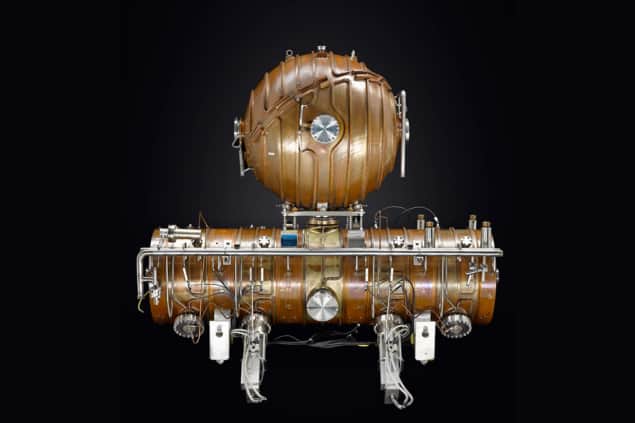Andrew Robinson reviews Curious Devices and Mighty Machines: Exploring Science Museums by Samuel J M M Alberti

“You owe me a new mobile,” grumbled Samuel J M M Alberti’s colleague after his daughter spotted her iPhone model in the new collection of National Museums Scotland. Like most people, the girl associated museums with historical artifacts and had concluded her phone was a relic that needed replacing right away. “Never mind that the exhibit was showing contemporary technology,” says Alberti in the introduction to his new book Curious Devices and Mighty Machines: Exploring Science Museums. “In her mind the museum was indelibly associated with bygones.”
But they have a wider remit, according to Alberti, who is director of collections at National Museums Scotland. As he goes on to explain, “Museums collect old and new, tangible and intangible, but most of all, they collect stories.” In fact, the organization, which oversees four museums including the National Museum of Scotland in Edinburgh, has been acquiring iPhones for a decade as an extension of its existing collections on communication, which begin with telegraphy.
Curious Minds and Mighty Machines is an experienced and enjoyable exploration of diverse aspects of the past and present of science museums
So how did curators choose from the two dozen iPhone models available and the billion handsets sold? In his chapter on collecting, Alberti explains that they went for handsets with stories. This thinking follows the example of, say, the National Museum of American History, where one of the most significant Apple products on display out of over a hundred is a simple Apple adapter that was found at the site of the World Trade Center following the attacks of 11 September 2001.
Thus each iPhone that National Museums Scotland has collected has a story. One was a prize in an online competition, shipped to Scotland in November 2007, just before the launch of the first-generation iPhone in Europe – making it perhaps one of the earliest examples to be used in the UK. Another handset was used by prominent videogame designer Mike Dailly, of YoYo Games, to develop Simply Solitaire (released in 2010), which was once Apple’s most popular free app. Meanwhile, an iPhone 3GS in the collection belonged to the photojournalist David Guttenfelder, who used it to take award-winning photographs of conflict zones for online channels such as Instagram, on which he was an early pioneer.

Blown away by the wonders of glass at Corning’s spectacular museum
Curious Minds and Mighty Machines contains many such stories. Alberti covers the ins and outs of how a science museum functions and the qualifications of curators. He talks about how objects are presented in permanent displays, temporary exhibitions and on the Internet to engage visitors of all ages, including young children. He also examines how science museums can be used to campaign against, for example, climate change and racism. In addition, we discover the treasures of museum storerooms, ranging from the microscopic to the mighty. Throughout, Alberti refers to most sciences and many collections, both well-known and not so familiar, but he keeps mainly to Europe, the US and Canada, with a particular focus on Scotland.
Given such a rich and varied subject, it is inevitable that certain museums, collections and objects are not included, but some of these omissions seem odd considering their significance. There is, for example, surprisingly little coverage of the history of computing. Indeed, the word “computing” does not even appear in the book’s index. Pioneers of computing such as Ada Lovelace and Alan Turing go unmentioned, while there is no reference to the National Museum of Computing at Bletchley Park.
The History of Science Museum in Oxford – located in the world’s oldest surviving purpose-built public museum building – is underestimated. Its early history from 1924 is only briefly touched upon, and little is said of its distinguished objects. Indeed, the most famous item in its collection, the blackboard that Albert Einstein used in Oxford in 1931 for his lecture on relativity and the age of the universe is completely neglected in Curious Minds and Mighty Machines.

Einstein in Oxford
The omission is ironic given Alberti’s talk of museums collecting stories because the blackboard is linked to a wonderful tale that began with some Oxford dons wanting to immortalize the legendary scientist’s visit. Their desire prompted historian of science Robert Gunther – who was pivotal in establishing the History of Science Museum – to request the lecture organizers to donate the blackboards. Einstein firmly opposed the idea and was annoyed when two ephemeral blackboards were taken after his second lecture. No doubt he would have found it amusing had he learned that one of them is now blank – having been accidentally cleaned in the museum! You can read about it in my Physics World feature on Einstein’s unique trip to Oxford.
Despite these questionable omissions, Curious Minds and Mighty Machines is an experienced and enjoyable exploration of diverse aspects of the past and present of science museums. The book lives up to the intriguing photograph on its cover, which a journalist described as looking like “a copper robot from the golden age of sci-fi”. It is in fact a radio-frequency accelerating cavity from CERN’s Large Electron–Positron collider, which operated from 1989 to 1995 and was donated by CERN to National Museums Scotland.
- 2022 Reaktion Books 269pp £20.00
